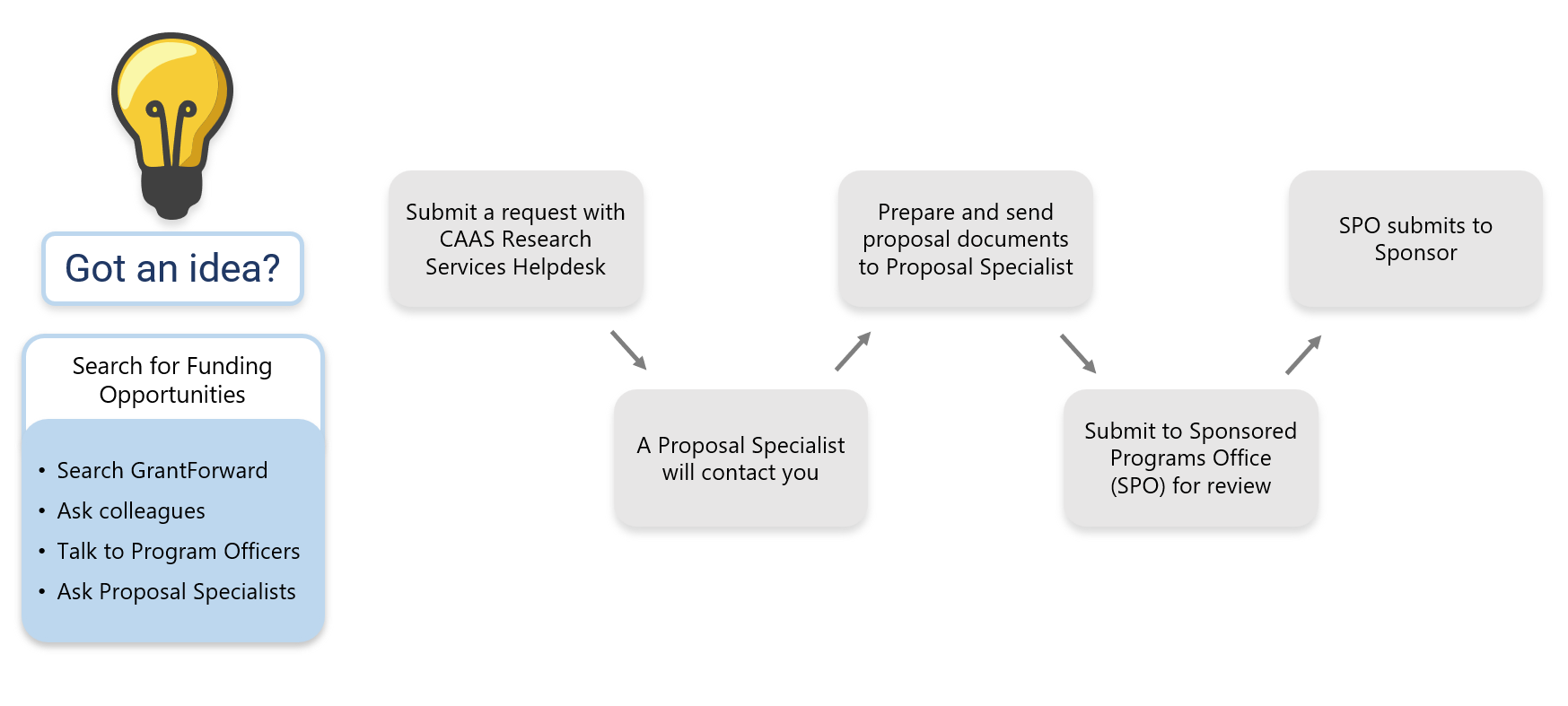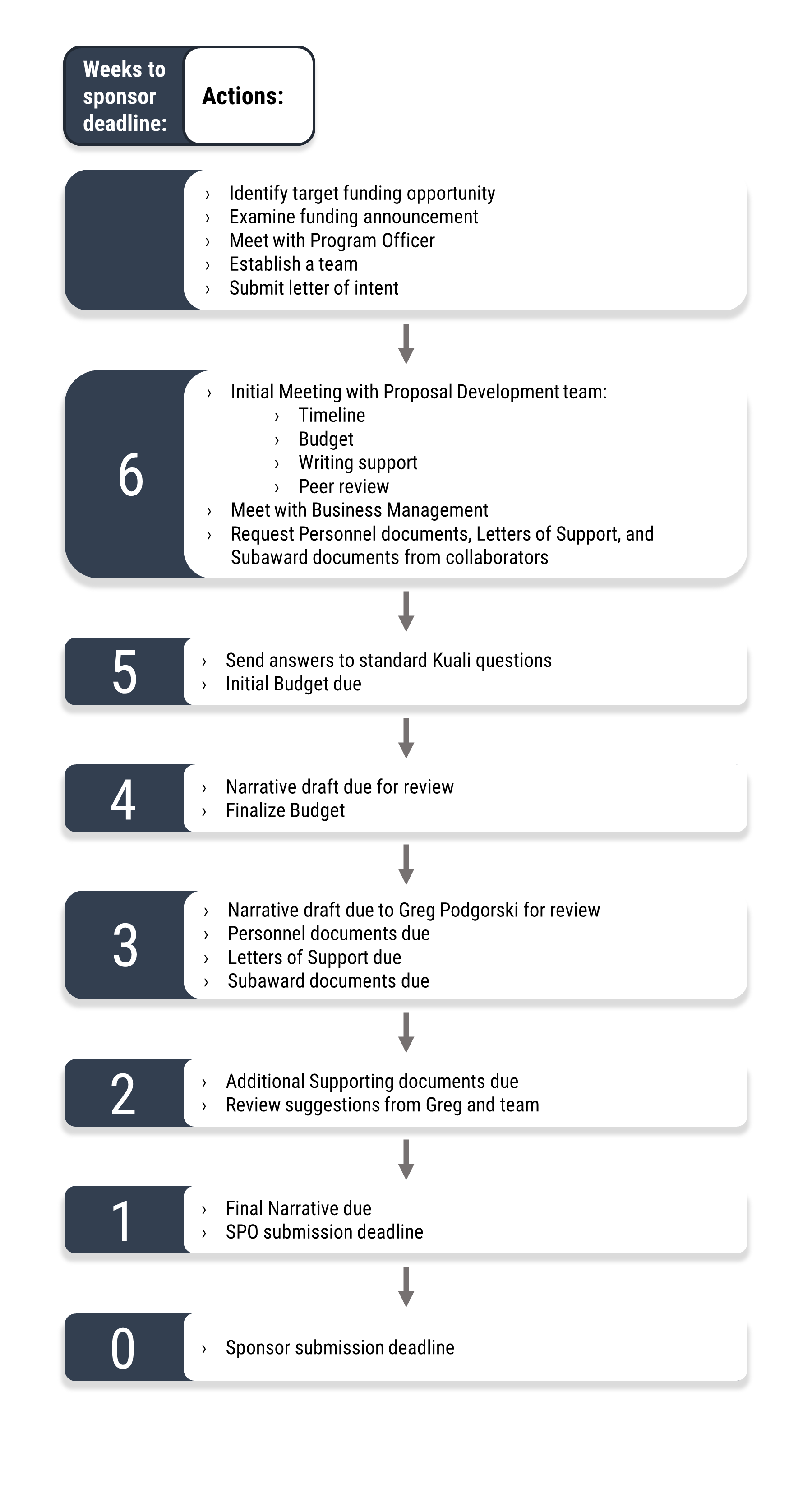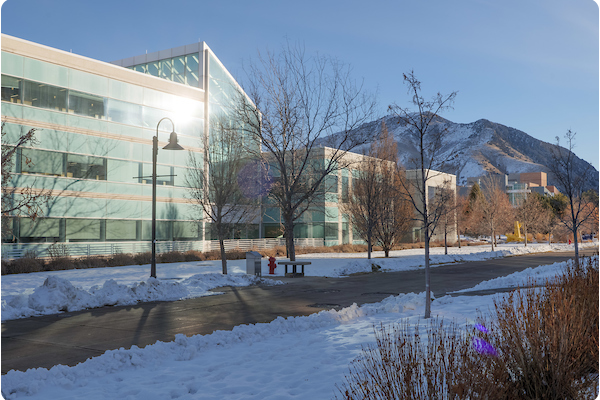Submitting a grant with CAAS Research Services

USU uses Kuali to review, submit, and track all grant proposals. All proposals must be prepared and submitted in Kuali for internal review and approval. A proposal specialist with CAAS Research Services can help you prepare your Kuali proposal. Use the CAAS Research Services Helpdesk to request help.
While PIs may prepare Kuali proposals without the help of a proposal specialist, PIs are not authorized to submit proposals. All proposals must be submitted by an Authorized Organization Representative (AOR) in the Sponsored Programs Office (SPO).
Learn more about using Kuali from the Kuali Research page and schedule an appointment with Dan Perry to receive one-on-one instruction for using Kuali.
Proposal Development Timeline
After submitting a request using the CAAS Research Services Helpdesk, a proposal specialist will contact you to discuss a timeline for preparing your proposal. The sooner you submit a request the better!
We typically request 6-8 weeks, or 4 weeks minimum, to prepare a proposal submission; however, this depends on the complexity of the grant requirements.
Search for funding opportunities
- GrantForward is a search engine dedicated to helping institutions and individuals find grants to fund their research.
- Receive personalized grant recommendations.
- Learn more about GrantForward and fine helpful videos from the GrantForward Youtube page.
- Search for funding opportunities from federal agencies on Grants.gov
- Use the Grants Learning Center to learn more about federal grant applications
- Utah's Funding Opportunities Portal provides access to state & federal funding opportunities.
- Find funding opportunities from various foundations using Candid's Foundation Directory
Preparing your proposal
Where to start
Once you decide to apply for a grant, we recommend making a simple outline of your project and then build a budget first. This will help you know what you can afford and avoid writing a proposal that is too ambitious for the target grant. As you talk to collaborators and program officers, your idea may evolve and you can adjust your budget as necessary, but carefully check the funding announcement for allowable expenses. We also recommend that you talk to the business manager from your department to ensure that your budget follows university policy.
Below are helpful descriptions of common budget components to consider as well as advice for writing and reviewing your proposal.
Budget considerations
Salaries and fringe benefits
Fringe benefits must also be included in a proposal budget. Check for current rates from the Office of Research (see the table entitled "Staff Rates Used for Contract/Grant Proposal Preparation").
One month of a $60,000 salary:
8.33% x $60,000 = $5,000.
Fringe benefits:
$5,000 x 44% = $2,200
Graduate students
Undergraduate students
Subawards
USU requires collaborating institutions to submit the Subrecipient Compliance Form, which must be completed by the collaborating institution's Authorized Organization Representative (AOR). In addition to the subrecipient compliance form, USU also requires the following documents (listed on page 2 of the compliance form):
- Letter of commitment (signed by the subrecipient's AOR)
- Scope/statement of work (SOW)
- Budget
- Budget justification
- Indirect cost rate agreement
When collaborating with investigators from other institutions, make sure to contact them early to request the necessary documents.
Equipment
Travel
USU policies vary for domestic and international travel. Consider the following expenses for travel:
- Flights
- Car rental
- Mileage
- Per diem rates
- The number of days
Find current per diem and mileage rates from the Travel Office, as well as the Travel dashboard, forms, and travel training.
Facilities & administration (F&A)
F&A, also called indirect costs or overhead, supports university operations (e.g. electricity, maintenance, administration cervices). F&A rates are federally negotiated and listed on the Negotiated Indirect Cost Rate Agreement (NICRA).
F&A is calculated as a percentage of the Modified Total Direct Costs (MTDC) for a project. MTDC includes only:
- all direct salaries and wages,
- applicable fringe benefits,
- materials and supplies,
- services,
- travel,
- and up to the first $25,000 of each subaward (regardless of the period of performance of the subawards under the awards).
Example:
Salaries & fringe: $7,200
Supplies: $10,000
Travel: $5,000
Equipment: $6,000
46% x ($7,200+$10,000+$15,000)
= $14,812
Cost share/matched funds
Some programs may require cost share/matched funds. For example, they may require that you match the requested funds dollar for dollar. Some common sources for matching are faculty salaries and other funded grants; matching through in-kind donations is discouraged.
Make sure to plan your budget early and talk to both the program officer and the business manager from your department or college to ensure your matched funds are appropriate and acceptable. Unless directly required by the funding program or recommended by the program officer, matching funds is generally discouraged.
Writing your proposal
Getting started
Start early! Writing a successful grant proposal takes time and attention.
When planning your proposed project, consider the following questions:
- What is the problem you intend to address?
- How will your proposal solve the problem?
- Is your solution innovative and collaborative?
- Will your proposal have a high chance of success?
- How are you or your team equipped and qualified to complete the proposed work?
Keep the answers to these questions in mind while writing and weave them into your grant proposal to instill confidence in the reviewers.
Read the funding announcement. Do your goals align with the funding agency's goals for the program? Do the allowed expenses fit your needs? See below for more tips on reading a funding announcement.
Know your budget. What do you need to pursue your project and how much will it cost? Keep this in mind when searching for funding opportunities.
Talk to the program officer. Email a one paragraph description of your project proposal to the program officer to ask for feedback. Program officers can tell you if your proposed project is a good fit for the program. If it is not a good fit, then they may be able to suggest an alternative funding opportunity. Program officers are busy and may not have time to respond immediately, but continue to follow up.
How to read a funding announcement
Funding agencies, or sponsors, may have different grant programs with distinct requirements. The requirements will be published in a document called something like a Request for Applications (RFA), a Request for Proposals (RFP), or a Notice of Funding Opportunity (NOFO). These are all essentially the same thing, but here we'll use RFA for consistency. These documents can be dense and difficult to read. However, carefully reading an RFA is essential for preparing a successful proposal. Here are some details to look for when reading an RFA:
When is the proposal due? Will you have enough time to prepare it?
Is a pre-proposal or letter of interest required or encouraged? If so, will you have enough time to prepare it?
Does the grant align with your needs? Read the section in the opportunity entitled “Abstract,” “Summary,” “Purpose,” “Priorities,” or “Objectives” get an idea of what the sponsor wants to accomplish with the grant to see if it is aligned with your goals.
Check for Eligibility- Are public/state-run universities like USU eligible to apply?
- Are land-grant universities eligible to apply? USU is an 1862 Land-Grant institution. It is not an 1890 Land-Grant institution (historically Black college/university [HBCU]). It is also not a 1994 tribal land grant college/university.
- Are universities with Agricultural Experiment Stations eligible to apply?
- Can USU submit more than one or two submissions per year for this opportunity? If not, this is a Limited Submission, and applicants must work with SPO to apply.
- Must a university work with another organization to apply (e.g., an Indian tribe, small farmers, K-12 teachers, industry partners, etc.)?
- Are only certain states/counties/cities eligible?
- Must you be a member of a particular organization to apply?
- Must you be of a particular sex/gender, race/ethnic status, citizenship, student type, or faculty level?
How much funding is available for each grant, and what will the grant fund? Most grants have specific requirements for what they will or will not fund, e.g. salaries or equipment may not be allowed.
Are cost share/matching funds/in-kind donations required? (Do a search for these terms.)
What platform is required for submission? (Grants.gov, ASSIST, EDGE, Research.gov, foundation portal, email, etc.)
Are there additional instructions found elsewhere? Many sponsors will also have additional instructions either as a downloadable file, webpage, informational webinar, “office hours” Q&A sessions, etc. Thoroughly search the RFA and the sponsor website for additional resources.
Writing the project narrative
Write an outline to plan your main points. This simple step is crucial for preparing a well organized proposal and provides a clear roadmap for writing.
Keep the audience in mind. Who will review your proposal? What is the reviewer's background? Be careful to not over use acronyms and avoid jargon that a reviewer might not understand.
Be brief, concise, and clear. A poorly written proposal that is too long or repetitious will frustrate reviewers who are very busy and may be at the end of a long day of reviewing proposals. Keep the reviewer happy!
Write with confidence. A good proposal has a convincing story. Incorporate sentences throughout to explain the importance of your proposed project, why it will be successful, and why you and your team are qualified to carry out this project.
Read the evaluation criteria. As you write your proposal, make sure you have a strong answer for each of the criteria. This is what reviewers will use to score your proposal, so use the evaluation criteria as a checklist.
Ask others for feedback. Discuss your ideas with others in your field, and ask someone experienced in grant writing to review your proposal. Be humble and open to suggestions.
Read and re-read the RFA. Check that your proposal is complete and meets all of the requirements.
Carefully proofread your proposal. Mistakes can be distracting to reviewers and convey a lack of professionalism.
Writing a budget justification
Most but not all funding agencies require a budget justification to explain the expenses included in your budget. This is a chance to explain in greater detail why you need what you need for your project. Some funding agencies may have a template for you to use, so carefully check the RFA and agency website, especially if the template is required. Use these templates as a starting point for your budget justification.
Budget Justification Templates:
Checklists for typical federal grant proposals
Please review the RFA to ensure program-specific requirements are met.
National Science Foundation (NSF):
- Cover Sheet
- Project Summary
- Project Description
- References Cited
- Biographical Sketch (SciENcv)
- Collaborators & Other Affiliations
- Budget
- Budget Justification
- Subaward Budget & Justification
- Cost Sharing
- Current & Pending Support (SciENcv)
- Facilities, Equipment, and Other Resources
- Special Information and Supplementary Documentation
- Postdoctoral Mentoring Plan
- Data Management Plan
- Letters of Collaboration
National Institutes of Health (NIH):
- Cover Page
- Budget
- Budget Justification
- Project Summary/Abstract
- Project Narrative
- Bibliography & References
- Facilities & Other Resources
- Equipment
- Biographical Sketches (SciENcv)
- Research Plan:
- Introduction
- Specific Aims
- Research Strategy
As applicable:
- Vertebrate Animals
- Select Agent Research
- Multiple PD/PI Leadership Plan
- Consortium/Contractual Arrangements
- Letters of Support
- Resource Sharing Plan(s)
- Authentication of Key Biological and/or Chemical Resources
- Appendix (FOA specific)
- Human Subjects and Clinical Trials Information
U.S. Department of Agriculture (USDA):
- Project Summary
- Project Description
- Bibliography & References Cited
- Facilities & Other Resources
- Equipment
- Letters of Support
- Biographical Sketch
- Current & Pending Support
- Budget
- Budget Justification
- Subaward Budget & Justification
- Data Management Plan
USU Internal Documents (as applicable):
- Target RFA/FOA/NOFO
- F&A Allocation Agreement Form
- Indirect Cost Rate Agreement
- Cost Share Commitment Form
- Consultant Letter
- Proof of Nonprofit Status
- Subaward Compliance Form:
- Letter of Commitment
- Statement of Work
- Budget
- Budget Justification
- Indirect Cost Rate Agreement
Make the most of USU Library resources
- Meet with a Librarian
- Learn about writing a Data Management Plan for your proposal
- Learn about Open Access Policies to make your research more accessible

You received an award, now what?
All awards are handled by the Sponsored Programs Office (SPO) and Sponsored Programs Accounting (SPA).
Please visit the SPO and SPA websites to find out who is assigned to work with your department. They will work with you, the sponsor, and any subawardees to negotiate the final terms of the award.


